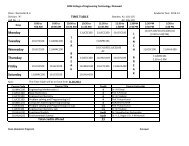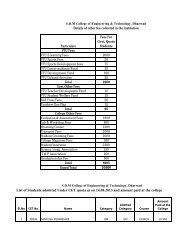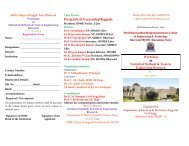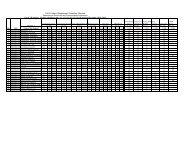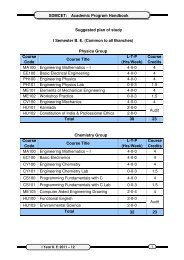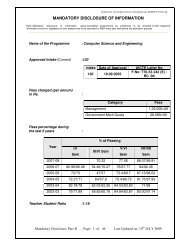SDM Utsav Souvenir - SDMCET
SDM Utsav Souvenir - SDMCET
SDM Utsav Souvenir - SDMCET
- TAGS
- utsav
- souvenir
- sdmcet
- sdmcet.ac.in
Create successful ePaper yourself
Turn your PDF publications into a flip-book with our unique Google optimized e-Paper software.
Contribution of Technology for better health care.<br />
Dr. K. Ramesh Chandra Naidu<br />
B.Sc., M.D[Anesthesiology], D D E., PG DHRM<br />
Former Prof & Head, Anaesthesiology & Palliative care KIMS, Hubli<br />
In his 46th presidential address to the Indian science<br />
congress,Dr A.L.Mudaliar, pays his tribute to great discoveries<br />
in the fields of physical sciences, biological sciences, the<br />
technical and technological sciences for the phenomenal and<br />
significant progress achieved in every branch of Medicine<br />
during the past fifty years. This was in 1959. Much water has<br />
flown under the bridge in the past 50 years.This union of<br />
medicine with other sciences has become so strong that it<br />
would be appropriate to say that the diagnosis and<br />
management decisions of today are totally dependent on<br />
these advancements. The synergy has been further enhanced<br />
by other subjects like material sciences, computer sciences,<br />
semiconductor technology, tissue, neural, nuclear,&genetic<br />
engineering and communication technology. Earlier, we<br />
were happy to apply the existing technologies, but now,<br />
“INNOVATE” seems to be the vision of those scientists who<br />
are involved in these projects.<br />
Despite the improvement in various fields, developing<br />
countries like India still face manpower shortage. Over 60<br />
percent who live in the villages have to trudge long distances<br />
to seek quality medical care. Though infectious diseases have<br />
been largely contained, more and more people are facing<br />
chronic, degenerative, often crippling illnesses. It has been<br />
predicted that there willbe a great increase in the >60 year<br />
olds and of course,age-related problems, by 2015. India has<br />
already appeared prominently in the diabetes and<br />
hypertension world map.<br />
In this scenario, newer technologies are taking Medicare to<br />
the less privileged. Way back in 1996 India launched the<br />
Health channel “Medindia” providing consultation at a fairly<br />
low cost. Good progress was done in 1996 by using the V-SAT<br />
equipment. After 2000, many states successfully established<br />
Telemedicine units where data from a node can be uploaded<br />
onto a communication channel for diagnosis and<br />
management at a specialized institution. Tele radiology<br />
t e c h n i q u e s , w h i c h c o m p r i s e o f t r a n s m i t t i n g<br />
compressed,archival images in real time, have been designed<br />
for considering urgent interventions in fields like cardiology.<br />
Computerized health records, records of ECGs, ultra sound,<br />
audio and video can all be transmitted by this method.<br />
Using micro fluidics, Lab on chip technologies have made it<br />
possible to provide accurate, precise and fast diagnosis in<br />
infections, cancers, testing safety and efficacy of drugs etc.,<br />
either at the bedside, or in poorly equipped, remote areas<br />
without a full-fledged laboratory support(the point of care<br />
testing).<br />
Key- hole or laparoscopic surgery has made it possible to<br />
undertake complicated surgical maneuvers through a small<br />
incision which reduces hospital stay for the patient. “Da<br />
Vinci” is arobotic device which combines flexible tools and<br />
imaging techniques to perform minimally invasive surgeries,<br />
as an alternative to traditional laparoscopic surgery: it comes<br />
at a cost however, the device costs something like 1.75<br />
million dollars! The cyber knife:robotic stereotactic<br />
radiosurgery is another such invention.It uses radiation<br />
produced from a small linear particle accelerator, and a<br />
robotic arm to direct the radiation more accurately to any<br />
part of the diseased tissue, under radiological image<br />
guidance. As a non- invasive technique, it is applicable to<br />
patients whose general condition is not suitable for routine<br />
surgery.<br />
One of the specialties which has benefitted greatly by<br />
technology is cardiology. The 64 slice CT scan has been<br />
shown to give a foreboding of an impending vascular block.<br />
The state of theheart can also be known throughCardiac MRI,<br />
positron emissiontomography, Echocardiography, and<br />
vascular Doppler. Prosthetic valves, pacemakers,<br />
implantable defibrillators are now becoming cheaper. Who<br />
would have believed in surgery on the beating heart a few<br />
decades ago?<br />
In the field of Anesthesiology, Continuous flow machines<br />
have given place to work stations which integrate monitoring<br />
systems and ventilators with digital control, making the<br />
delivery of anesthetic agents and gases highly specific. The<br />
Intensive care unit of today is totally built on a computerized<br />
architecture, providing a total intensive care to the seriously<br />
ill.<br />
Advances in Dialysis at institution and home, have given<br />
hope of survival to hundreds of patients suffering from end<br />
stage renal disease. The contribution of material sciences has<br />
also been well recognized. Acrylics, plastics, various glues,<br />
ceramic, metals, have all been used in making prostheses and<br />
implants, grafts and drug eluting stents. Research is going on<br />
regarding adoption of newer materials.<br />
A combination of physics, chemistry,biotechnology, material<br />
sciences and computer technology has presented an exciting<br />
avenue-“Nano technology”.Nano drugs and bio markers are<br />
offering a great opportunity in treating several crippling<br />
diseases including cancer. The new buzz word is stem cell<br />
therapy. By using these multi potent cells, a variety of<br />
conditions like Parkinson's disease, Alzheimer's disease,<br />
18



